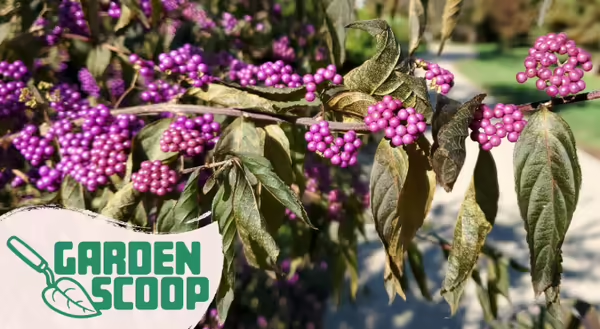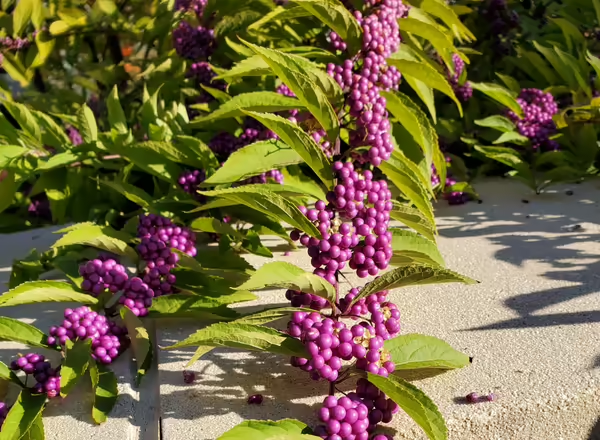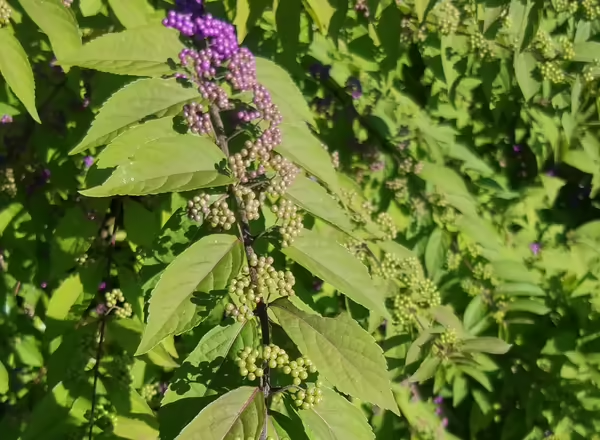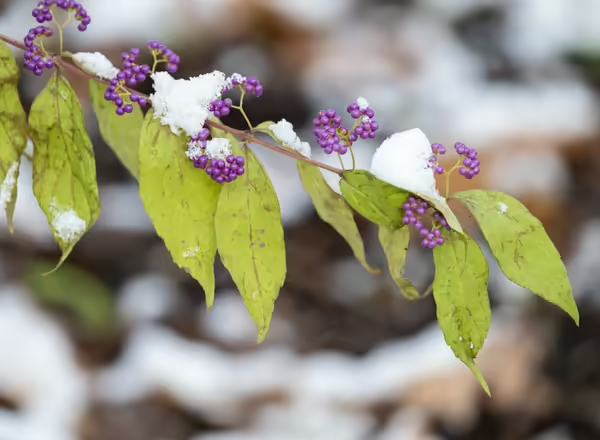
Each year in late summer and fall, beautyberry catches my eye and reminds me of its fantastic fruit display. This spectacular fall shrub is a member of the Genus, Callicarpa, which hosts around 140 species globally and countless numbers of cultivars that are available commercially today.
In the US, our native species (C. americana) spans the southern states but does not occur in Illinois, although it is well-adapted and commonly planted in the landscape. Across this Genera, its common name is quite appropriate as the bright purple berries hold attractive beauty well into the winter season.
Beautyberry as an ornamental
As summer fades to fall, dense clusters of metallic-purple fruit mature along stems, encircling them at each leaf axil. Berries ripen from the inner locations to the tips, creating a wonderful contrast between green berries on branch tips and mature, purple berries along lower stems before the entire crop matures sometime in October.
I often think of mid-October as the peak ornamental period for this plant. Its fall color ranges from yellow to almost purple and slowly creeps in as the berries reach full maturity. The contrasting colors between foliage and fruits put on a nearly unmatched display in the fall.
Growing beautyberry
In the landscape, beautyberry is a performer, flourishing in a wide range of soil conditions and tolerating full sun to nearly full shade. It is most at home in well-drained soils with a substantial amount of organic matter, but tolerates everything from clay to sand. Fruit development is best in full sun, but even in partial shade, this plant will produce a noteworthy display.
Perhaps its biggest weakness in the Illinois landscape is the cold. This plant is hardy from Zone 6 all the way down to Zone 12, with a native range that encompasses swaths of northern Mexico and the Caribbean. Similar to other less-hardy woody plants, like butterfly bush (Buddleja spp.), it’s known to die back to the ground in Zone 5, or even in Zone 6 during harsh winters. However, this resilient plant produces berries on new wood, so any winter dieback does not impact the following year’s berry crop.
Beautyberry is typically a smaller shrub, reaching about 5 to 6 feet tall at maturity, although I have seen some older specimens on the right site reach 8 to 10 feet in height. The branching habit of this plant is also a major ornamental attribute, with gently arching stems that create a shrub canopy equally as wide as tall. Its fine-textured leaves and dense clusters of berries are the icing on the cake.
While this plant can work well as a specimen when grouped with other contrasting plants, I think I have enjoyed it most when planted in large groups or along borders. The cumulative effect of abundant purple berry clusters this time of year is truly a showstopper. Its graceful, arching branch habit simply creates the perfect frame for clustered, purple berries.
Medicinal uses
Beyond its use in the landscape, beautyberry has long been used as a medicinal plant, with records of Native American use spanning the ages. In recent years, scientific research has explored many of the historic uses as well as some newer found applications.
Historic records point to beautyberry being used as a natural insect repellent for both humans and livestock. Many accounts note that simply rubbing leaves on skin will repel mosquitoes, and recent research has uncovered up to five chemical compounds responsible for their mosquito-repelling qualities.
In addition, other compounds isolated from beautyberry have been found to boost antibiotics when taken in tandem. These compounds are being studied to fight ‘superbugs’ that develop resistance to typical antibiotics. In addition, some research points to the potential for other compounds in beautyberry to be used as antiviral treatments.
Historically, plants in the genus Callicarpa, meaning “beautiful fruit” in Greek, have been used to treat various ailments, from fever, headache, and indigestion to several types of cancer. In recent decades, significant research efforts have explored more and more about the chemical compounds these plants produce and their uses.
Whether you’re fascinated by its potential healing compounds or just want a pop of color in your fall garden, beautyberry won’t disappoint. Consider adding this plant to your landscape for a splash of purple berries that extend into the winter months.
Photo Caption: Beautyberry has captivating purple berries that occur in clusters along the stem to create a fantastic display in fall and winter each year. Pictured here is the non-native species, C. dichotoma.



Anya et al. 2003. Allelochemical potential of Callicarpa acuminata. Journal of Chemical Ecology 29, 2761-2776.
Cantrell et al. 2005. Isolation and identification of mosquito bite deterrent terpenoids from leaves of American (Callicarpa americana) and Japanese (Callicarpa japonica) beautyberry. Agricultural and Food Chemistry 53(15), 5948-5953.
Contreras et al. 2014. Flower, fruit, petiole color of American beautyberry are controlled by a single gene with three alleles. HortScience 49(4), 422-424.
Jones et al. 2007. Cytotoxic constituents from the fruiting branches of Callicarpa americana collected in southern Florida. Journal of Natural Products 70(3), 372-377.
Jones, WP and AD Kinghorn. 2008. Biologically active natural products of the Genus Callicarpa. Current Bioactive Compounds 4(1), 15-32.
Nghakliana et al. 2023. Ethnopharmacological applications and phytochemical compounds of the Genus Callicarpa L. Bioactive and Pharmacology of Lamiaceae 1, 24.
Pineau et al. 2019. Growth inhibitory activity of Callicarpa american leaf extracts against Cutibacterium acnes. Frontiers in Pharmacology 10, 466336.
Tellez et al. 2000. Composition and some biologic activities of the essential oil of Callicarpa americana (L.). Journal of Agriculture and Food Chemistry 48(7), 3008-3012.